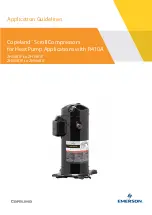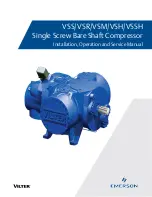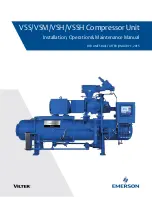
12
CRANKCASE COVER
1. Remove the four crankcase cover cap screws (29)
securing the crankcase cover (28) to the crankcase
(21). Using a soft mallet, gently tap the crankcase cover
to break the gasket seal. Remove the crankcase cover
gasket (27).
REAR END COVER & COVER PLATE ASSEMBLY
NOTE: Mark position of the rear end cover. It should be
re-installed in the same orientation.
1. Remove the two cap screws (33) and lock washers (34)
from the rear end cover (25).
2. Remove the rear cover plate (32) and rear cover plate
gasket (30).
3. Remove the four end cover cap screws (26) that secure
the rear end cover to the crankcase.
4. Remove the rear end cover (25) from the crankcase.
5. Remove the o-ring seal (24) from the rear end cover
(25).
CLEANING OF PARTS GENERAL
All parts should be cleaned in a good commercial grade of
solvent and dried prior to inspection.
CYLINDER HEAD ASSEMBLY
1. Carefully remove all gasket material adhering to the
cylinder head (13), cooling plate (15), valve plate
assembly (16) and cast iron crankcase (21). Make
certain not to scratch or mar the gasket surfaces. Pay
particular attention to the gasket surfaces of the head.
2. Remove carbon deposits from the discharge and inlet
plate assembly. They must be open and clear in both
assemblies. Make certain not to damage the head.
3. Remove rust and scale from the cooling cavities and
passages in the cylinder head, cooling plate and valve
plate assembly and use shop air to clear debris from
the passages.
4. Check the threads in all cylinder head ports for
galling (e.g. abrasion, chafing). Minor thread chasing
(damage) is permitted.
INSPECTION OF PARTS
CYLINDER HEAD, COOLING PLATE, VALVE
PLATE ASSEMBLY AND UNLOADER MECHANISM
1. Carefully inspect the head gasket surfaces on the
cylinder head (13) for deep gouges and nicks. Also,
inspect the cylinder head for any cracks or port thread
damage. If detected, the compressor must be replaced.
If large amounts of carbon build-up are present in the
discharge cavity such that it restricts the air flow through
the cylinder head, the compressor should be replaced.
2. Carefully inspect both sides of the head gasket surfaces
on the cooling plate (15) for deep gouges and nicks.
Also, inspect the cooling plate for any cracks or other
damage. If found, the compressor must be replaced.
3. Carefully inspect the valve plate assembly (16) gasket
surfaces (both sides) for deep gouges and nicks. Pay
particular attention to the gasket surface. An inlet
reed valve/gasket (17) is used between the valve
plate assembly and crankcase. This gasket surface
must be smooth and free of all but the most minor
scratches. If excessive marring or gouging is detected,
the compressor must be replaced. If large amounts of
carbon build-up are present on the two main surfaces, in
the two discharge valve holes or between the discharge
valve and the discharge seat, the compressor should
be replaced.
4. If the unloader assembly has been removed from the
cylinder head, the unloader assembly must be serviced
using the unloader kit.
See the Maintenance and
Service Parts listing in this manual for kit contents and
part numbers.
5. If large amounts of carbon build-up are present on the
unloader piston (10) seat or orifice or if the return spring
exhibits compression set, the unloader components
must be replaced with an unloader kit.
REAR COVER PLATE
Inspect the surface in direct contact with the gasket and
rear end cover plate (32). Remove any remaining gasket
material from the surface. There should be no gouges in
the surface directly in contact with the gasket.
If the rear cover plate (32) has been removed, it must
be serviced with the seal kit.
See the Maintenance and
Service Parts listing in this manual for kit contents and
part numbers.
REAR END COVER
Check for cracks and external damage. Check the
crankshaft rear journal diameter for excessive wear, flat
spots or galling. Check the cover plate threaded mounting
holes for thread damage. Minor thread chasing is permitted
but do not re-cut the threads. Carefully inspect the gasket
surface on the back of the rear end cover (25). (Note: This is
the surface the rear cover plate is in contact with). Remove
any remaining gasket material on the surface. This gasket
surface must be smooth and free of all but the most minor
scratches. If excessive marring or gouging is detected, the
compressor must be replaced.













































